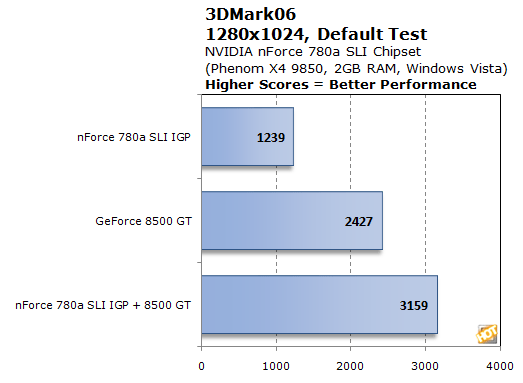NVIDIA nForce 780a SLI Motherboard Round-Up
Hybrid SLI Testing: GeForce Boost

As we mentioned earlier, one of the nForce 780a SLI's main features is support for Hybrid SLI, when paired up with a compatible graphics card. The new modes available with Hybrid SLI are "GeForce Boost" and "Hybrid Power". With GeForce Boost, an entry level graphics card (currently the 8400 GS or 8500 GT) can be paired up with the nForce 780a SLI IGP for increased performance, or a high-end graphics card (currently the 9800 GTX or 9800 GX2) can be used for more demanding 3D applications while the IGP is used in less taxing scenarios.
We tested both modes of operation with a GeForce 8500 GT or GeForce 9800 GTX.
|
|
|



GeForce Boost with the 8500 GT seemed to work quite well for increasing 3D performance. As you can see in the results above, pairing the discreet card and IGP together resulted in significantly increased performance in F.E.A.R. and 3DMark06. Crysis showed a slight gain, but that was likely due to the benchmark's margin of error and not GeForce Boost mode in and of itself.

For increased power savings, NVIDIA recommends users connect their display to the nForce 780a SLI IGP's video output even when a more powerful graphics card is installed in the system. The frame buffer from the more powerful card is copied over to the IGP's shared memory, where it is then output to the screen. NVIDIA claims there is only a very minor performance penalty associated with the process, so we decided to do a quick test to see for ourselves. As the results above show, there is a small hit when using the motherboard's video output. We should note, however, that there is also a significant power savings using the motherboard's output, as we'll show you next.






